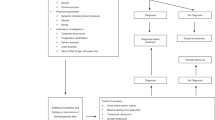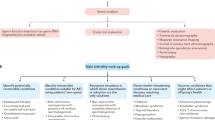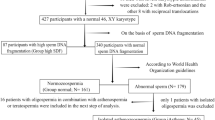Abstract
The presence of blood in the semen—hematospermia—is an anxiety-provoking but usually self-limiting condition. Its exact incidence remains unclear. The risk of underlying malignancy, despite being very low, drives evaluation. There is confusion amongst clinicians as to how best to refer, evaluate and treat men with hematospermia. We have reviewed the literature in an attempt to present a cohesive view of the etiologies and diagnostic and management strategies in patients with this condition.
This is a preview of subscription content, access via your institution
Access options
Subscribe to this journal
Receive 12 print issues and online access
$209.00 per year
only $17.42 per issue
Buy this article
- Purchase on Springer Link
- Instant access to full article PDF
Prices may be subject to local taxes which are calculated during checkout



Similar content being viewed by others
References
Mulhall, J. P. & Albertsen, P. C. Hemospermia: diagnosis and management. Urology 46, 463–467 (1995).
Leary, F. J. & Aguilo, J. J. Clinical significance of hematospermia. Mayo Clin. Proc. 49, 815–817 (1974).
Narouz, N. & Wallace, D. M. Hematospermia: in the context of a genitourinary medicine setting. Int. J. STD AIDS 13, 517–521 (2002).
Han, M., Brannigan, R. E., Antenor, J. A., Roehl, K. A. & Catalona, W. J. Association of hemospermia with prostate cancer. J. Urol. 172, 2189–2192 (2004).
Ahmad, I. & Krishna, N. S. Hemospermia. J. Urol. 177, 1613–1618 (2007).
Papp, G. K., Hoznek, A., Hegedüs, M. & Juhàsz, E. Hematospermia. J. Androl. 15, 31S–33S (1994).
Jinza, S., Noguchi, K. & Hosaka, M. Retrospective study of 107 patients with hematospermia. Hinyokika Kiyo 43, 103–107 (1997).
Fletcher, M. S., Herzberg, Z. & Pryor, J. P. The etiology and investigation of haemospermia. Br. J. Urol. 53, 669–671 (1981).
Gattoni, F. et al. Transrectal prostatic echography in the study of hemospermia. An assessment of an 85-patient case load [Italian]. Radiol. Med. 91, 424–428 (1996).
Weidner, W., Jantos, C., Schumacher, F., Schiefer, H. G. & Meyhöfer, W. Recurrent haemospermia—underlying urogenital anomalies and efficacy of imaging procedures. Br. J. Urol. 67, 317–323 (1991).
Jones, D. J. Haemospermia: a prospective study. Br. J. Urol. 67, 88–90 (1991).
Golan, S. et al. Detection of sexually transmitted pathogens in patients with hematospermia [Hebrew]. Harefuah 144, 630–633 (2005).
Khan, M. S. et al. Low-grade phyllodes tumor of the seminal vesicle treated with laparoscopic excision. Nat. Clin. Pract. Urol. 4, 395–400 (2007).
Maheshkumar, P., Otite, U., Gordon, S., Berney, D. M. & Nargund, V. H. Testicular tumor presenting as hematospermia. J. Urol. 165, 188 (2001).
Singh, I. The sanguineous sperm (hemospermia)—current appraisal and review. Indian J. Surg. 67, 302–307 (2005).
Furuya, S., Furuya, R., Masumori, N., Tsukamoto, T. & Nagaoka, M. Magnetic resonance imaging is accurate to detect bleeding in the seminal vesicles in patients with hemospermia. Urology 72, 838–842 (2008).
Lu, C. H., Chen, W. C., Wu, H. C. & Lu, H. F. Transrectal ultrasonographic findings in patients with hemospermia. Zhonghua Yi Xue Za Zhi (Taipei) 63, 558–562 (2000).
Etherington, R. J., Clements, R., Griffiths, G. J. & Peeling, W. B. Transrectal ultrasound in the investigation of haemospermia. Clin. Radiol. 41, 175–177 (1990).
Cho, I. R. et al. Magnetic resonance imaging in hemospermia. J. Urol. 157, 258–262 (1997).
Lencioni, R. et al. (1999). Endorectal coil MR imaging findings in hemospermia. MAGMA 8, 91–97 (1999).
Torigian, D. A. & Ramchandani, P. Hematospermia: imaging findings. Abdom. Imaging 32, 29–49 (2007).
Yang, S. C., Rha, K. H., Byon, S. K. & Kim, J. H. Transutricular seminal vesiculoscopy. J. Endourol. 16, 343–345 (2002).
Cattolica, E. V. Massive hemospermia: a new etiology and simplified treatment. J. Urol. 128, 151–152 (1982).
Coppens, L. Diagnosis and treatment of obstructive seminal vesicle pathology. Acta Urol. Belg. 65, 11–19 (1997).
Jin, H. M., Zhan, B. Y. & Wang, L. L. Massage of transrectal heat rotating magnetic field in the treatment of obstinate hemospermia [Chinese]. Zhonghua Nan Ke Xue 12, 60–65 (2006).
Fuse, H., Sumiya, H., Ishii, H. & Shimazaki, J. Treatment of hemospermia caused by dilated seminal vesicles by direct drug injection guided by ultrasonography. J. Urol. 140, 991–992 (1988).
Zhang, X. R. et al. Transrectal ultrasonography-guided transperineal bilateral seminal vesicle puncture and continuous irrigation for the treatment of intractable hematospermia. Chin. Med. J. (Engl.) 121, 1052–1054 (2008).
Singh, I., Sharma, N., Singh, N. & Gangas, R. Hematospermia (ejaculatory duct calculus)—an unusual cause. Int. Urol. Nephrol. 35, 517–518 (2003).
Bamberger, E. et al. Detection of sexually transmitted pathogens in patients with hematospermia. Isr. Med. Assoc. J. 7, 224–227 (2005).
Author information
Authors and Affiliations
Corresponding author
Ethics declarations
Competing interests
The authors declare no competing financial interests.
Rights and permissions
About this article
Cite this article
Aslam, M., Cheetham, P. & Miller, M. A management algorithm for hematospermia. Nat Rev Urol 6, 398–402 (2009). https://doi.org/10.1038/nrurol.2009.98
Issue Date:
DOI: https://doi.org/10.1038/nrurol.2009.98



